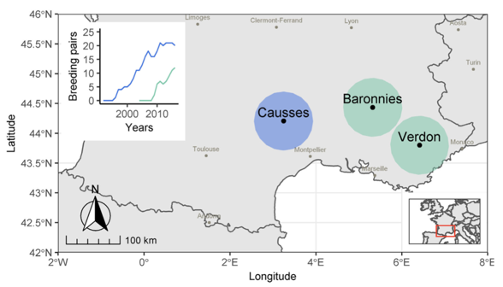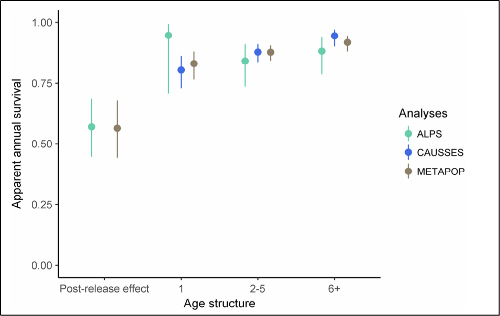
A recent study assessed the role survival and movements play in the long-term dynamics of a translocated Cinereous Vulture (Aegypius monachus) metapopulation in France.
Background
Reintroduction is crucial to restore depleted wildlife populations and decrease the extinction risk for endangered species. Reintroduction programmes have been key to the recovery of vulture populations in Europe. However, it is important to assess their effectiveness at different phases of the process: e.g. i) establishment, ii) growth and iii) regulation phase. Translocated population dynamics can be heavily influenced by the survival of translocated individuals and their movements between populations. For example, high dispersal from the release site can induce reintroduction failure if translocated individuals leave permanently the release site at the early stages of the reintroduction process. Post-release costs, such as decreased survival of translocated individuals, have been reported in birds. This can be due for instance to the lack of experience of released individuals in the wild. Yet it remains difficult to discriminate the relative importance of dispersal versus survival of translocated birds in determining post-release costs. The age of individuals to be released is another important point to be considered as survival and dispersal are age-dependent processes and age will therefore influence the outcome of reintroduction projects.
In this study, the authors took advantage of three reintroduction programmes of Cinereous Vultures in France over the last 25 years to assess post-release survival and between population movements. In France, Cinereous Vultures were first reintroduced in the Causses region in 1992 and 2004 and then in two other areas on the western border of the Alps, the Baronnies (2004-2018) and the Verdon (2005-2020) (Figure 1). The Alpine populations are still in their establishment phase and therefore it is still early to assess its success.
The authors used capture-recapture data from the long-term monitoring program following these reintroductions in order to assess if survival and movement were impacted by: (1) individual factors such as age and origin (wild-born or released), (2) environmental and social factors related to the local characteristics of each region (Causses and Alps), and (3) release methods (age at release, time spent in captivity).

Short methods and main findings
A total of 20,580 data distributed on 4,656 different days and collected between 1992 and 2016 for birds released and birds born in the wild between 1992 and 2015 were considered in this analysis. All reintroduced individuals (n = 119: Causses, 53; Alps, 66) were marked (with plastic and metal rings) prior to release, and all (known) wild-born individuals were marked in the nest before fledging (n = 164: Causses, 145; Alps, 19).
In order to carry out our analyses at local (population) and regional (metapopulation) scales, the authors developed two variants of multi-event capture-mark-recapture (CMR) models. The first set of “population” models was used to estimate survival probabilities in each local population (Causses and Alps) considered as isolated (e.g., movements were disregarded). The second set of “metapopulation” models was used to estimate movement and survival probabilities within the metapopulation (e.g., between-population movements were considered).
Survival rates at population and metapopulation scale
Results showed that region or bird origin (wild-born or released individual) did not affect survival, except for individuals reintroduced in the Alps that had reduced survival during the first year after release.
When conducting the analyses at the metapopulation scale on a larger dataset, there were no differences in apparent survival between regions (Figure 2). These results suggest that apparent annual survival at local population scales differed between populations because of asymmetric emigration patterns rather than mortality.
In contrast, results highlighted a strong post-release cost on survival for birds reintroduced in the Alps, independently of the method of release considered and at both population and metapopulation scales (Figure 2). Since there was no difference in the release protocol implemented in both regions, the post-release cost of survival in the Alps is more likely explained by individual heterogeneity among released birds. Different factors could be involved in individual quality related to mortality causes, e.g. the origin of the reintroduced individuals, their body conditions, or the genetic diversity of released groups. However, these hypotheses could not be tested in this study.

This study also found that in the Causses, adult survival was lower than shown by previous research and could result from strong interspecific competition for food availability with Griffon vultures, unless this decrease in survival rates is related to undetected changes in anthropogenic mortality in this region.
Movements between restored populations
In contrast, region and bird origin influenced movements as, overall, individuals from the Causses (wild and released) generally exhibited more erratic behaviours than those from the Alps. However, vultures released in the Causses showed limited movements and strong fidelity to the release site the first year after release, compared to wild-born birds and individuals released in the Alps. This pattern might be linked to the geographic isolation of the population in the Causses before the reintroduction started in the Alps.
An important finding of this study was that movements between both regions were asymmetrical, with the Alps attracting overall more birds and in higher proportions from the Causses than the opposite. Consequently, the limited dynamic of the breeding population of Cinereous Vultures observed in the Causses since the late 2000s (when breeding started in the Alps) may be at least partly explained by these asymmetrical dispersal patterns driven by conspecific attraction.
As expected, age also influenced Cinereous Vulture movements, with adults being mostly sedentary while the behaviour of juvenile and immature birds was more erratic. However, despite the movements highlighted between populations, individuals retained a marked tropism toward their site of origin. Interestingly, among the old individuals established in the Alps, 11% of those originating from the Causses moved back to settle in the Causses.
Ring loss probabilities
Accounting for ring loss is very important to avoid underestimating demographic parameters. The plastic ring loss probability was relatively high and increased as the age of the bird increased. The rates of plastic ring loss were higher than in other vulture species, which could be related to the extremely powerful beak and neck musculature of the Cinereous Vulture
Many birds had lost their metal ring could not be identified anymore, which prevented the quantification of metal ring losses. The authors suggested that ringing new individuals and re-ringing marked individuals with locked metal rings would likely limit ring loss since locked metal rings are expected to be permanent and then improve demographic monitoring of Cinereous Vulture populations.
Implications for conservation
This study confirmed that aviaries vs. hacking methods did not have an impact on the reintroduction of Cinereous Vultures whereas the efficiency of the reintroduction in terms of post-release survival and dispersal was site-specific. These asymmetric erratic movements do not necessarily imply that Cinereous Vultures attracted to the Alps may jeopardize the viability of the Causses population, however, it may explain the decrease in the population growth rate in the Causses during the last decade.
Metapopulation restoration might compromise local viability dependent on the establishment of released individuals and metapopulation connectivity dependent on a sufficient degree of movement among populations. Since movement and survival were respectively higher and lower in young compared with adults, the authors recommend starting metapopulation translocations by releasing adults for enhancing establishment success at the release site. In a second phase, releasing young and securing successful breeding into the wild would increase population growth and connectivity.
Citation: Rousteau, T., O. Duriez, R. Pradel, F. Sarrazin, T. David, S. Henriquet, C. Tessier, and J.-B. Mihoub. 2022. High long-term survival and asymmetric movements in a reintroduced metapopulation of Cinereous vultures. Ecosphere 13(2):e03862. 10.1002/ecs2.3862.



